This Khaman Dhokla recipe makes a wonderfully soft and fluffy, lightly sweet, spiced and savory gram flour cake that’s perfect to enjoy anytime of the day. It’s easy to prepare, quick and instant Khaman recipe steamed on the stovetop or even in the Instant Pot with my step-by-step photos, video and instructions.
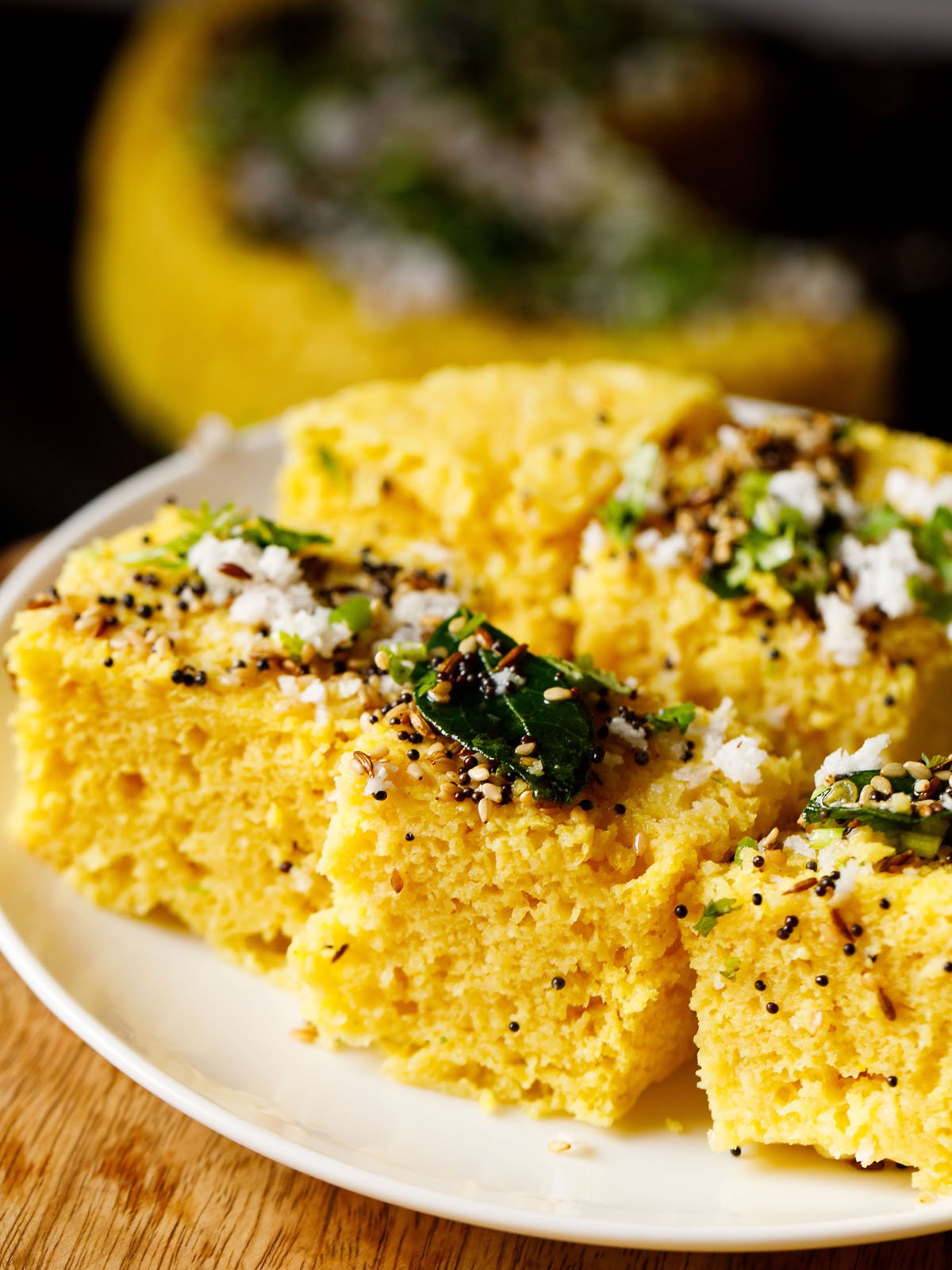
About Khaman Dhokla Recipe
Khaman, also known as Khaman Dhokla in other Indian states, is a popular delicacy from the Gujarati cuisine.
This popular light and spongy snack is made with a leavened batter of a spiced gram flour batter, that is later steamed in a pan. A tempering of spices and herbs is made which is then drizzled over this steamed cake.
This recipe makes a light, spongy dhokla and includes a hint of great savory flavor from a simple combination of gram flour (besan), spices, and herbs.
If you are wondering what is gram flour, it is simply is finely ground hulled black chickpeas. We also call it besan in Hindi.
Table of Contents
To leaven the batter instantly, there are a few ingredients you can use, that I have listed below. It is the reaction between the acidic lemon juice and the choice of leavening ingredient that aerates the batter, which helps in giving the Khaman its characteristic rise, softness and fluffiness.
Khaman is a healthy savory-sweet snack that happens to be vegan. Plus, it can be gluten-free too, if you skip semolina and asafoetida in the batter.
Khaman is also known as Yellow Dhokla as it has a yellow color or Besan Dhokla. It is also known as Instant Khaman.
I prepare Khaman Dhokla recipe with the steaming method either in an Instant pot or in a pan.
They’re perfect to enjoy for a hearty and satisfying breakfast or an afternoon or evening snack.
Dhokla vs Khaman
Khaman is popularly referred to as Khaman Dhokla but in actuality, a dhokla is made differently than khaman.
Dhokla is made with ground, fermented batter of rice and lentils like chana dal or urad dal. It is also called Vati Dal Dhokla in Gujarati.
While khaman recipe is made instantly with gram flour batter which is leavened by adding baking soda, citric acid or fruit salt. Khaman batter is not fermented unlike a dhokla batter.
The batter is leavened instantly using any of the leavening ingredients that you prefer. This leavened batter is then steamed in a greased pan like a steamed cake.
In the taste department, fermentation gives dhokla a really complex flavorsome taste, but a khaman also tastes equally great.
The color of dhokla can range from cream to light yellow or yellow but a khaman always has a bright yellow color.
Choice of Leavening Ingredients
To make soft and fluffy khaman dhokla you can choose between three leavening ingredients or a use a mix of two of them. Fruit salt, baking soda and citric acid are these ingredients and let us know more in detail about them.
1. Eno (Fruit Salt)
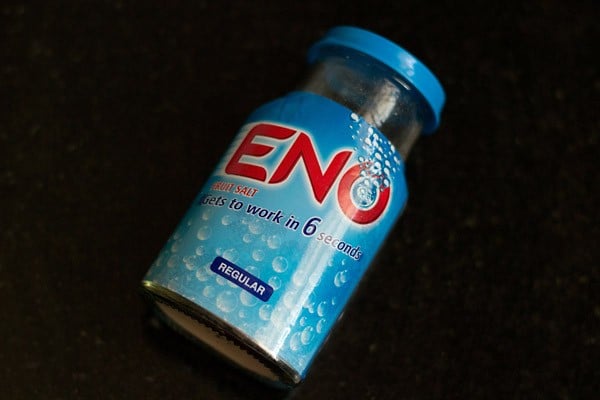
As a leavening agent, I use in this khaman recipe is fruit salt which results in a light and fluffy texture. Eno is a popular Indian brand of fruit salt that is used to relieve acidity and heartburn.
Fruit salt is composed of citric acid, sodium bicarbonate (baking soda), and sodium carbonate.
Sodium bicarbonate and sodium carbonate are effervescent ingredients that bubble and release carbon dioxide when added to water.
2. Baking Soda or Eno
To make khaman dhokla recipe, you can also use baking soda. But baking soda gives its soapy aroma if used in excess, so be careful not to add too much.
Eno gives you a perfect fluffy and soft khaman while the one made with baking soda is not that fluffy or spongy.
I personally prefer to use eno in khaman recipe as it gives the best results. I do not favor baking soda, as firstly we cannot stand the soapy aroma and secondly the texture is not that airy or spongy in comparison to the khaman dhokla recipe made with eno.
Use eno that is fresh and within its shelf period. If your eno is not fresh or active, the texture of khaman will be flat and dense. And please do not use flavored eno – the regular eno without any flavor works the best.
Both eno and baking soda react with turmeric powder and gives a red tinge or red spots in khaman dhokla. So add little turmeric powder or skip it completely.
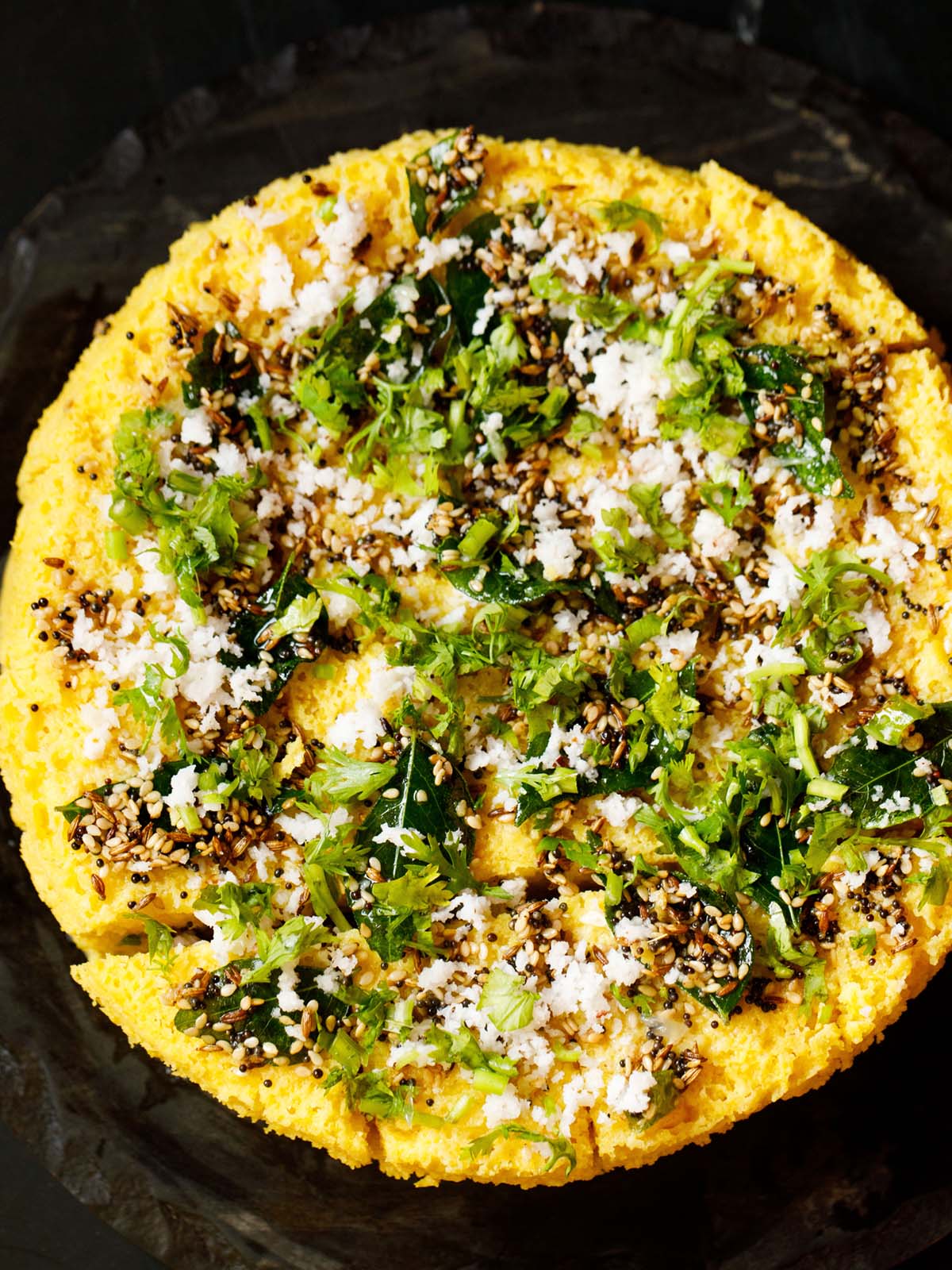
3. Lemon juice or Citric Acid
I have made khaman dhokla recipe both with lemon juice and citric acid. Citric acid gives a superb fluffy texture. Lemon juice also works great, but citric acid wins here. That said, use whatever is easily available to you.
To swap citric acid with lemon juice, use this standard proportion of:
1 tablespoon lemon juice = ¼ teaspoon citric acid (in the powdered form)
For citric acid, use a food-grade and pure citric acid. I also suggest including freshly squeezed lemon juice. Use a fresh lemon.
How to make Khaman Dhokla
Prep Pan
1. Grease a steamer pan with 2 to 3 teaspoons oil.
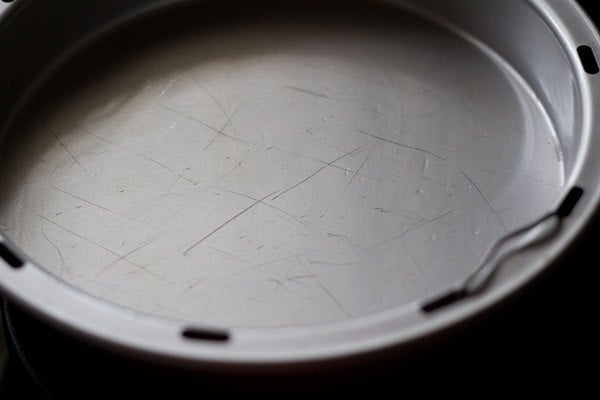
Make Batter
2. Take 1.5 cups gram flour (120 grams besan) in a mixing bowl or pan. Do use gram flour which has a fine texture.
Tip: You can make khaman with chickpea flour as well.
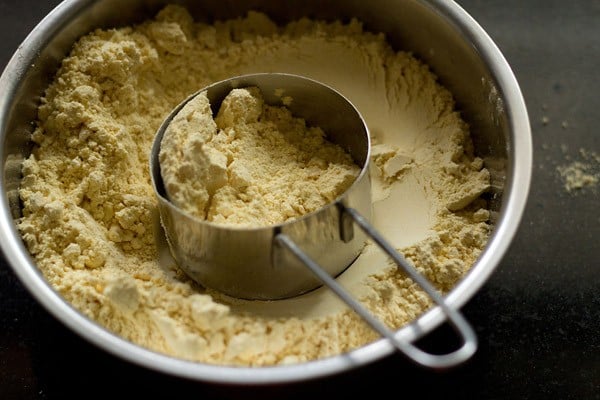
3. The add the following ingredients:
- 2 to 3 pinches of turmeric powder
- a generous pinch of asafoetida (skip to make a gluten-free version)
- 1.5 tablespoons lemon or lime juice or ⅓ to ½ teaspoon pure citric acid
- 1.5 teaspoons ginger paste (crush 1.5 inch ginger and 1.5 teaspoons green chilies in a mortar-pestle)
- 1.5 teaspoons green chili paste
- 1 tablespoon sugar or add according to taste
- 1 teaspoon salt or add as per taste
Tip: Avoid adding too much of turmeric powder as then the fruit salt or baking soda reacts with the turmeric powder and makes it red in color, thereby giving reddish dots, specks or tones in the khaman.
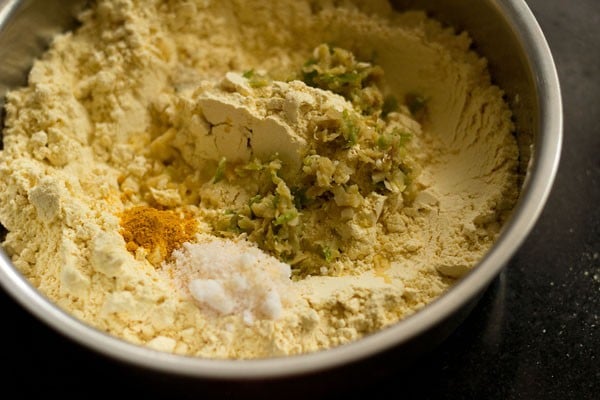
4. Add 1 cup water (or more or less as needed) and 1 tablespoon oil to make a thick yet smooth flowing batter.
The amount of water needed depends on the quality of flour, so start with 1 cup and add as required. Stir well to combine.
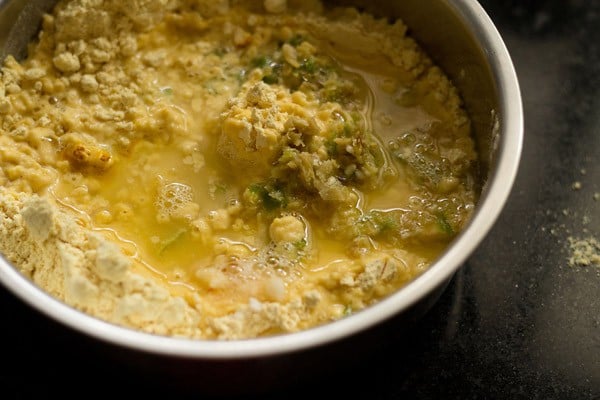
5. Then add 1 tablespoon rava (semolina). This is entirely optional but adds a good texture to the khaman. Skip rava or semolina for a gluten-free option.
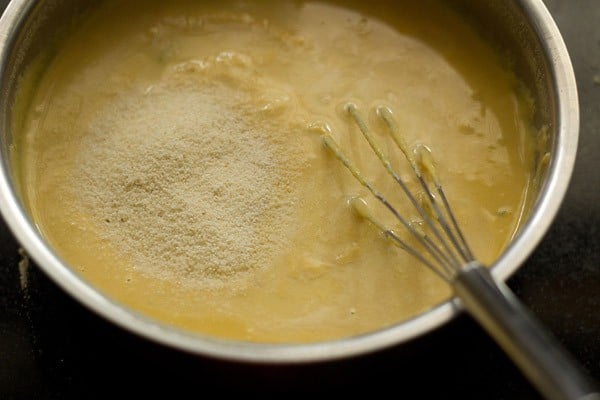
6. Stir with a whisk to create a smooth, thick batter without any lumps.
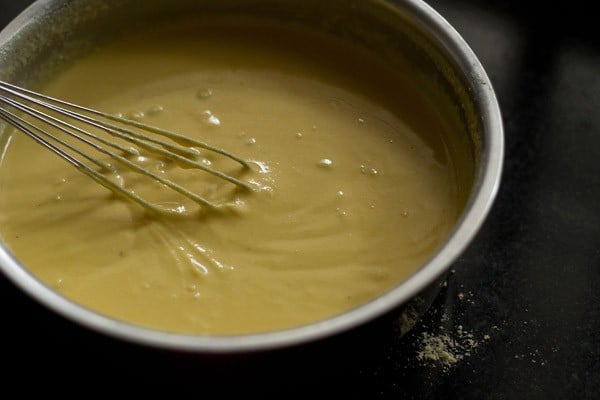
Batter Consistency
7. The batter should be thick yet flow easily off of the whisk. A quick tip is that if the batter becomes thin, then 1 to 2 tablespoons of gram flour.
Next bring 2 to 2.5 cups of water to a boil in a steamer pan or electric cooker or pressure cooker. The amount of water to be added depends on the size of the steamer or pressure cooker.
Note: To know more about the steaming in a pan, cooker and Instant Pot in detail, do read the tips section below.
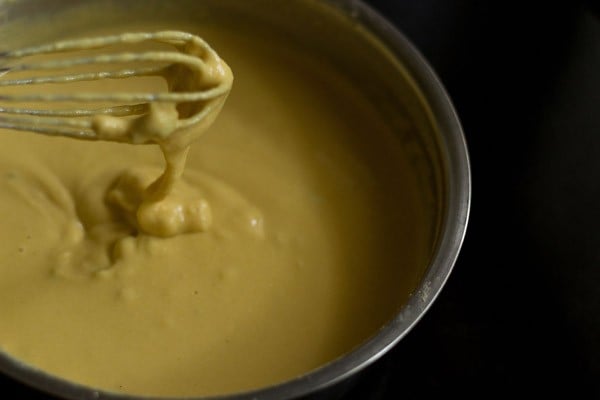
Leaven Batter
9. Next add 2 teaspoons Eno or fruit salt. 2 teaspoons of Eno makes the khaman soft and fluffy. But there is a slightly alkaline taste to Eno.
If you’re not a fan of this flavor then add only 1.5 teaspoons of Eno. If using baking soda as your leavening agent add ½ teaspoon to ¾ teaspoon.
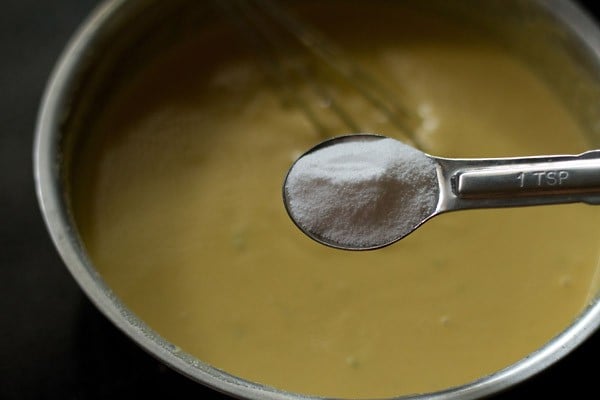
10. Stir and mix the eno with the batter briskly and quickly.
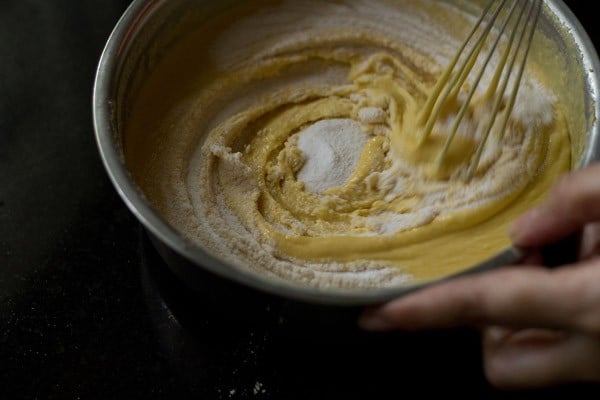
11. The fruit salt should be mixed evenly with the batter. Or else you get uneven texture in the khaman.
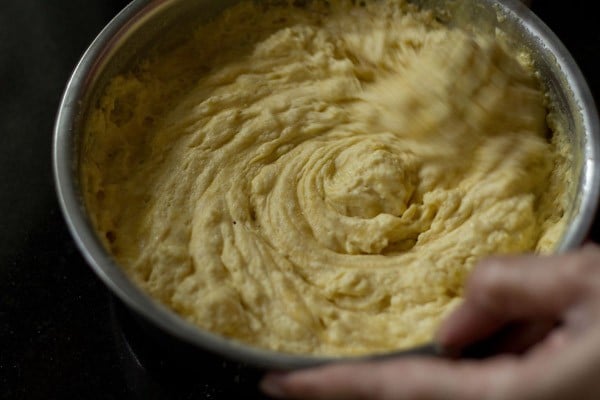
12. The eno will make the batter become frothy, so you need to work quickly to whisk it in thoroughly.
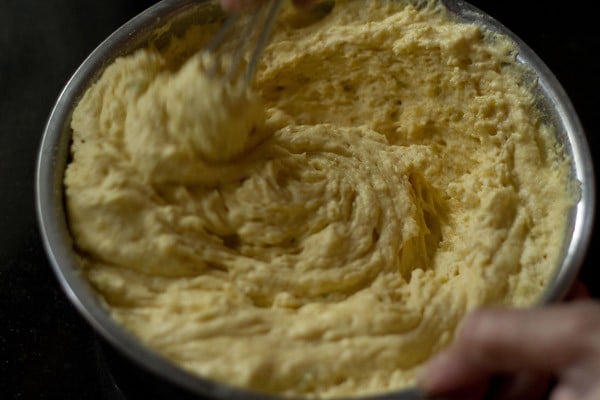
12. Pour the prepared batter into the greased pan.
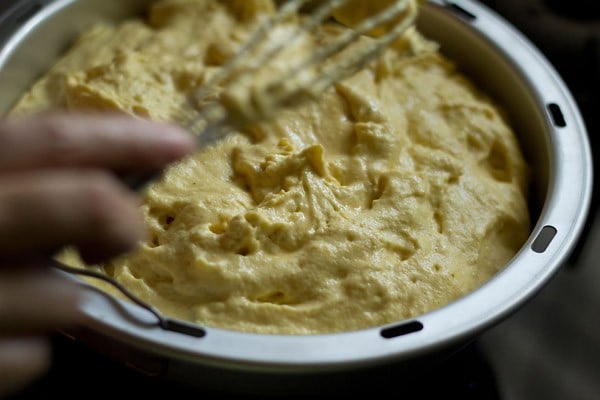
13. Gently shake so that the batter evens out in the pan. Below is a picture of the batter ready to be steamed.
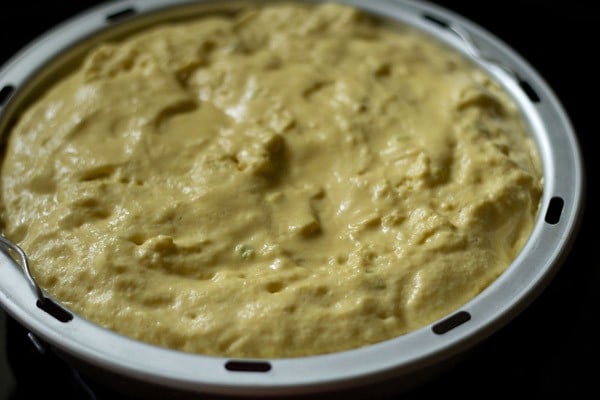
Steam
1. Place the pan in a steamer or electric rice cooker or pressure cooker. The water should already be boiling or hot when you place the pan with the khaman batter.
When using a pressure cooker, remove the vent weight/whistle from the lid and cover the cooker tightly with its lid.
Note: I have listed the detailed directions of steaming in a pan, pressure cooker and Instant pot in the tips sections below.
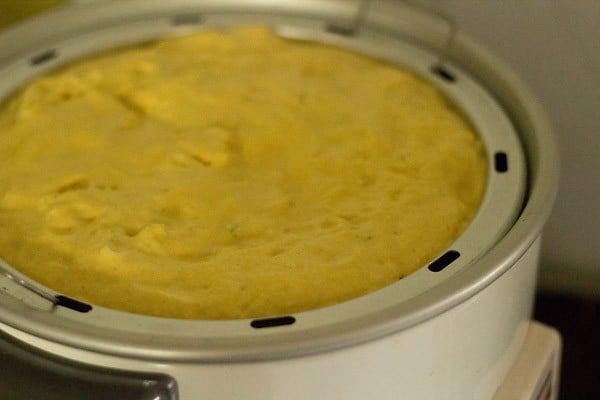
2. Steam for 15 to 20 minutes in an electric rice cooker. If using a pan or pressure cooker or Instant Pot, steam for 12 to 15 minutes on a medium to medium-high heat.
In the below photo the khaman is cooked for 17 minutes using an electric rice cooker.
You can begin working on the spice and herb solution for tempering the khaman while it cooks. Continue reading for the instructions.
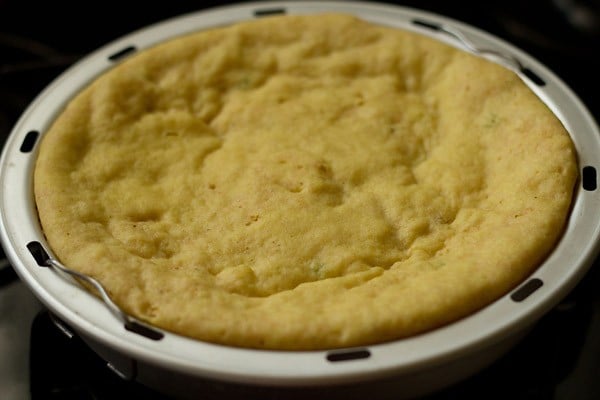
3. To check the doneness, insert a toothpick. It should come out clean if the khaman is done. If the toothpick has the batter on it, then you need to steam for another minutes or so.
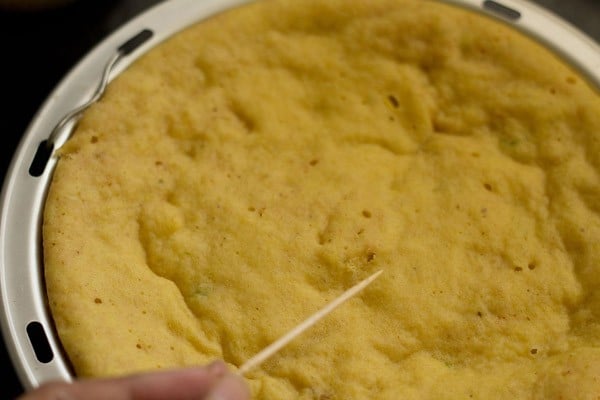
4. Let the khaman become warm or cool completely. Gently slide a butter knife along the edges to release the khaman from the pan. Place a plate or tray on top of the pan.
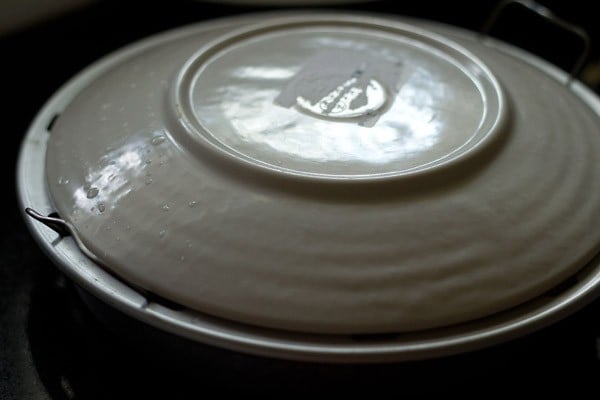
5. Then quickly invert the pan.
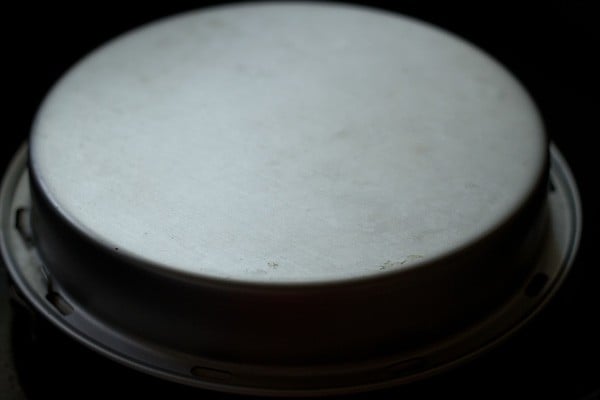
6. If greased well, the khaman will easily slide out onto the plate.
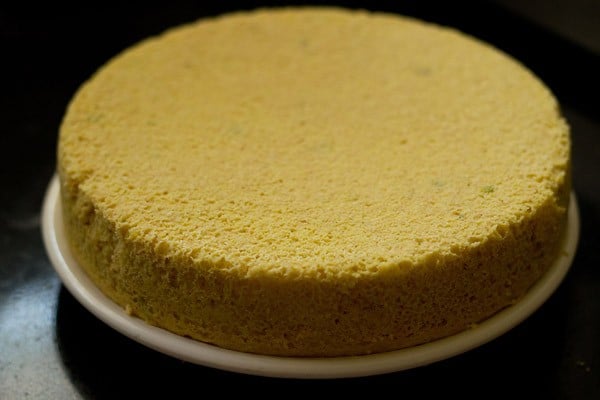
7. Use a sharp knife to slice the khaman in squares and set aside until ready to temper.
Since I used a concave plate, the khaman settled down in the center. This won’t happen if you use a flat plate.
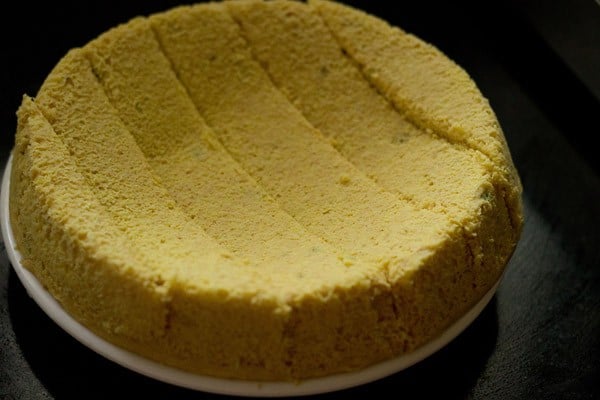
Temper Khaman Dhokla
1. Tempering is essential to infuse the khaman with flavor and add moisture to the gram flour sponge. To make the temper, first heat 2 tablespoons of oil in a small pan on the stove. Use peanut oil or any neutral-tasting oil.
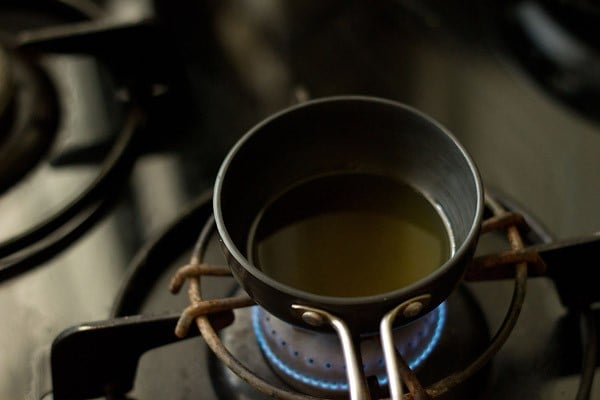
2. Add 1 teaspoon of mustard seeds and allow them to crackle.
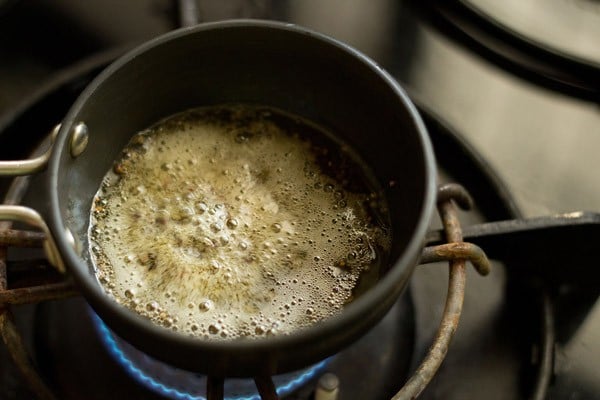
3. When the mustard seeds are crackling, add 10 to 12 curry leaves, and, if you like, 1 teaspoon of cumin seeds and 1 teaspoon of chopped green chili.
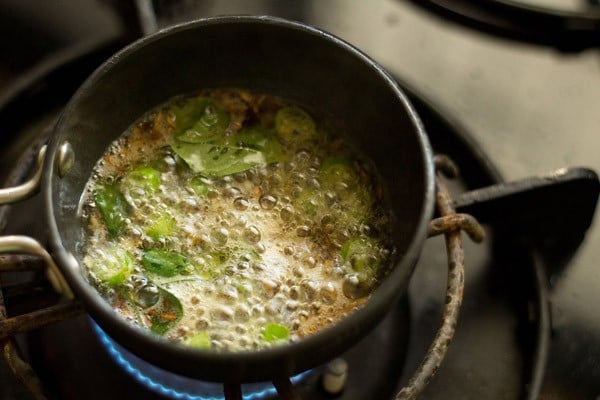
4. Stir and then add 2 teaspoons white sesame seeds.
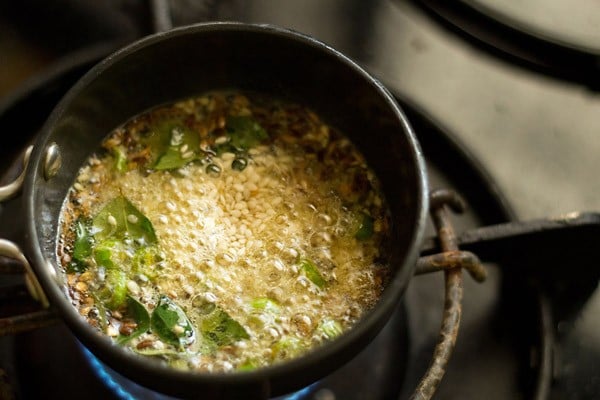
5. Fry the sesame seeds for some seconds. But don’t brown them or they’ll become bitter.
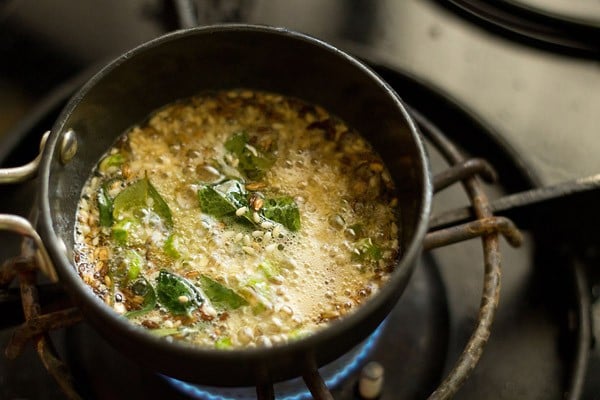
6. Next carefully add ⅓ cup of water. You can switch off the heat when adding water.
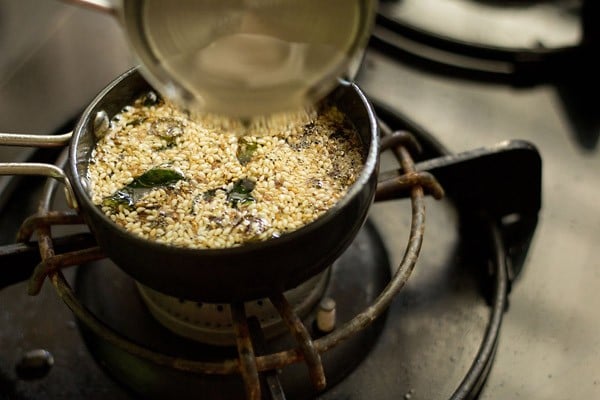
7. Next add 2 teaspoons of sugar.
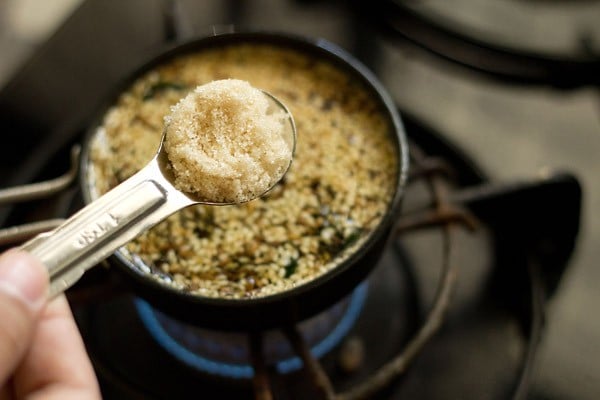
8. Stir and allow the tempering mixture to come to a boil. Make sure that the sugar is dissolved.
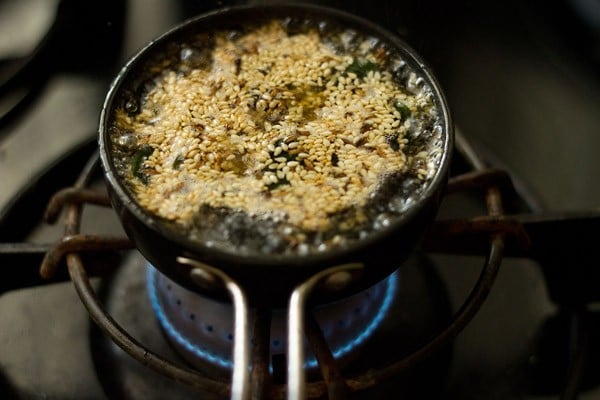
9. Remove from the heat and immediately pour this tempering mixture evenly on the khaman dhokla so that it seeps through the sliced edges.
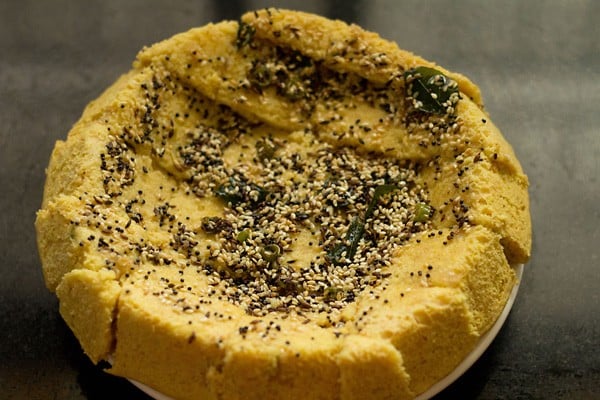
10. Garnish with 2 to 3 tablespoons of chopped coriander leaves and 2 to 3 tablespoons grated coconut, if you like.
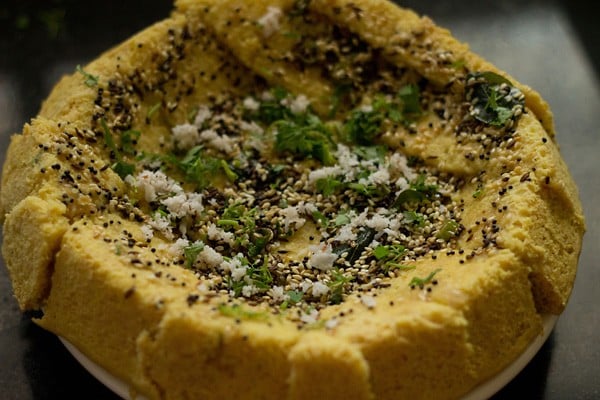
Serving Suggestions
Serve the Khaman Dhokla straight away or you can store it in an airtight box and serve later after an hour. If enjoying khaman later after several hours, then don’t add coconut until ready to eat.
You can also refrigerate them, and then when ready to serve just sprinkle some water and heat in a microwave for a few seconds until just warmed.
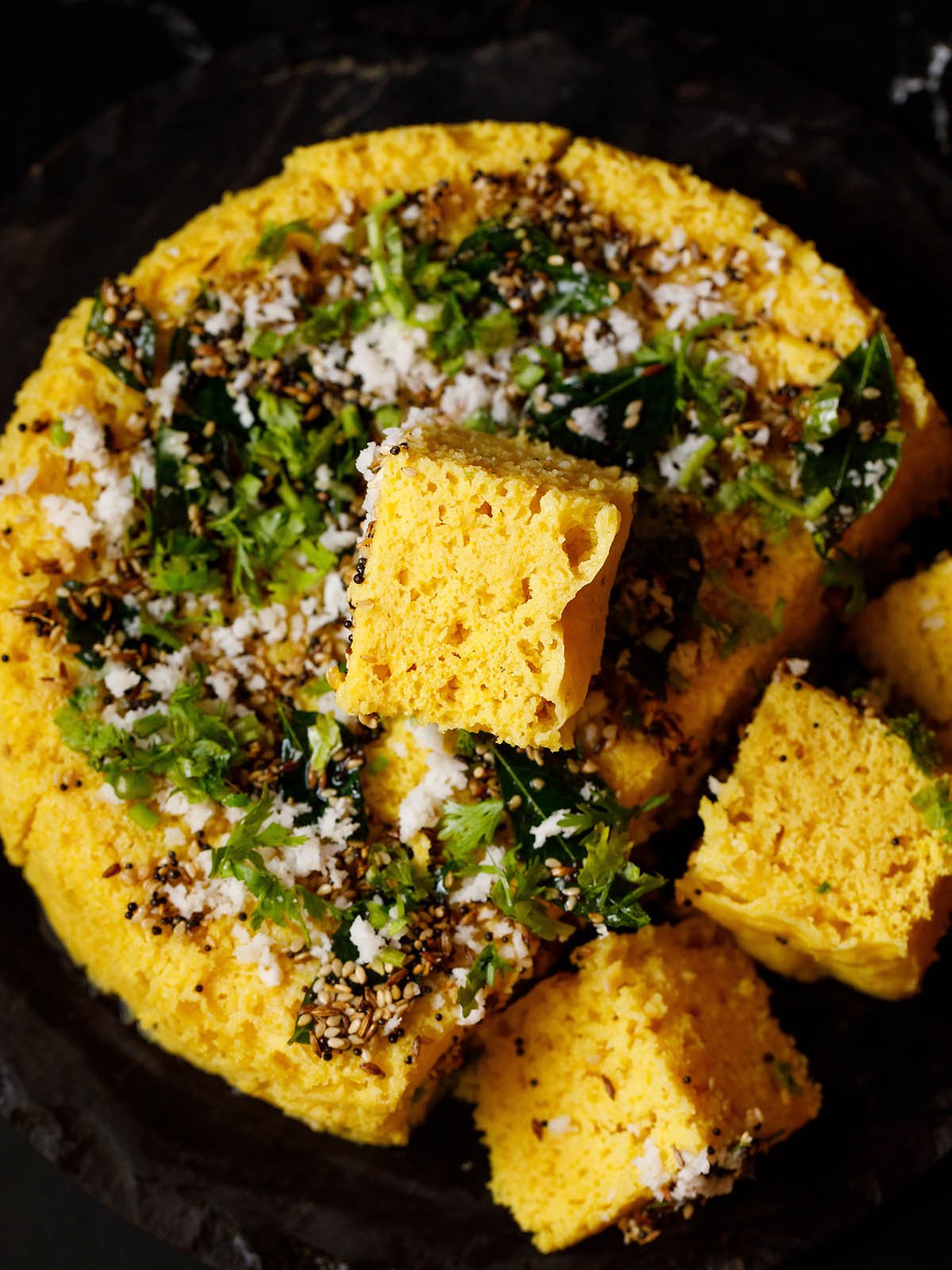
What to eat with Khaman
The sweet, savory, fluffy cakes pair great with our usual assortment of Indian chutneys like Papaya Chutney, Mint Chutney, or even Coriander Chutney.
We also like to pair it with Tamarind Chutney. You can also serve it as a healthy snack with your evening chai.
Storing Suggestions
If you plan to serve khaman after a few hours or next day, then I do not recommend to add coconut or coriander. Simply pour the tempering.
Refrigerate the khaman in a covered container. While serving you can warm with a sprinkling of water in a microwave or an oven.
If using the instant pot to warm, then steam for 1 to 2 minutes. While serving add the coconut and coriander leaves.
Expert Tips
Batter Consistency: The batter consistency has to be flowing but thick to medium-thick. 1 cup water with 1.5 cups of gram flour, always gives me perfect results, but you can add a few tablespoons of water if your batter looks very thick. A super thick batter will make the khaman hard and dense. A thin batter won’t hold shape and will become a mess.
Leavening Ingredient: Feel free to use any of the leavening ingredient. I usually make Khaman Dhokla recipe with eno. Simply ensure that your leavening ingredient is fresh and within its shelf period.
Flavor Adjustments: Khaman always has a sweet and tangy flavor. If you do not prefer the sweetness, I would suggest reducing the sugar but do not omit it entirely. The sweetness balances the tangy taste. You could though add the spices like green chillies and ginger according to your preferences.
Steaming: In a standard pan of 7 to 8 inches, it will take about 12 to 15 minutes for the batter to steam in a pan. Avoid overdoing the steaming as this may result in your Khaman becoming dry and crumbly.
Three Steaming Techniques
You can steam khaman in a pan, stove-top pressure cooker, or in an Instant Pot. I list below in detail on steaming khaman in each.
1: Steaming in a pan or pot
1. Place a small trivet in a large steaming pan that has enough room to keep the pan with the batter. Pour 2 to 2.5 cups of water. Bring it to a boil.
2. Place the batter pan as soon you mix with eno. Cover with a lid (not tight fitting) but one that has a vent or will allow some steam to pass through.
3. Steam for 12 to 15 minutes on medium-high heat. The deeper the pan is in touch with the boiling water, the faster the steaming is. If it is away from the boiling water, the steaming will take a bit more time.
2: Steaming in a stove-top pressure cooker
1. Place the trivet in a pressure cooker. Add 2 to 2.5 cups water. Heat the water until it begins boiling. Secure the pan tightly between tongs and carefully place it on the trivet.
2. Remove the whistle (vent weight) from the lid and seal the lid tightly. Steam for 12 to 15 minutes on medium to medium-high heat.
3: Instant Pot Steaming
1. Pour 2 to 2.5 cups of water in the steel insert of your IP. Place a trivet (not short or long, but kind of in between).
2. Use the sauté function and let the water get heated up and start simmering.
3. Using tongs or with oven mitts carefully place the pan with the khaman batter on the trivet. Do not cover with any lid.
4. Cover and seal IP with its lid and keep the vent position to steam release. Press the steam button and steam on high pressure for 12 to 15 minutes.
5. Keep a check of the time using a clock or watch as Instant pot does will not beep after the elapsed time and will continue to steam. Let all the pressure release and the valve fall down. Then open the lid carefully.
FAQs
The sponginess and light texture in the instant khaman dhokla recipe comes from reaction of eno with lemon juice or citric acid releasing carbon dioxide.
This reaction creates a fizzy bubbly mixture that helps the batter to rise and leaven thereby making it fluffy and spongy when steamed. So if you use less leavening agents (eno, baking soda) or if they are not fresh or active, your khaman won’t be spongy.
Turmeric powder reacts with baking soda or eno to give orange or red colored spots or patches in khaman dhokla. This makes your khaman turn orange or red. This can be avoided by adding less turmeric powder to the batter.
It can be eaten warm or at room temperature.
Adding too much of leavening ingredients like baking soda can make your dhokla bitter.
More Popular Gujarati Snacks!
Gujarati Food Recipes
Snacks Recipes
Gujarati Food Recipes
Gujarati Food Recipes
Please be sure to rate the recipe in the recipe card or leave a comment below if you have made it. For more vegetarian inspirations, Sign Up for my emails or follow me on Instagram, Youtube, Facebook, Pinterest or Twitter.
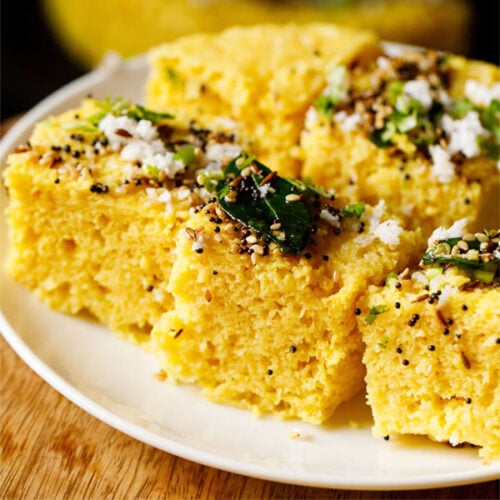
Khaman Dhokla Recipe (Instant Gujarati Khaman)
Ingredients
For khaman batter
- 1.5 cups gram flour (besan), 180 grams
- 1 tablespoon rava (semolina) – optional
- 1 tablespoon sugar
- 1.5 inches ginger – crushed to a fine paste in a mortar-pestle
- 1.5 teaspoons green chillies – chopped and then crushed to a fine paste in a mortar-pestle
- 2 to 3 pinches turmeric powder (ground turmeric)
- 1 to 2 pinch asafoetida (hing)
- 1 tablespoon oil – any neutral oil or peanut oil
- 1.5 to 2 teaspoons eno (fruit salt) or ½ to ¾ teaspoon baking soda
- 1 teaspoon salt or add as required
- 1.5 tablespoon lemon juice or ⅓ to ½ teaspoon pure food grade citric acid
- 1 cup water or add as required
For tempering khaman dhokla
- 2 tablespoons oil – any neutral oil or peanut oil
- ⅓ cup water
- 1 teaspoon mustard seeds
- 1 teaspoon cumin seeds – optional
- 2 teaspoons white sesame seeds
- 1 sprig curry leaves – about 10 to 12 curry leaves
- 1 teaspoon green chilies – chopped, optional
- 2 teaspoons sugar or add according to taste
For garnish
- 2 to 3 tablespoons coriander leaves – chopped (cilantro)
- 2 to 3 tablespoons coconut – grated and fresh, optional
Instructions
Making khaman batter
- Grease a steamer pan with 2 to 3 teaspoons of oil.
- Take besan or gram flour in a mixing bowl or pan.
- Add turmeric powder, asafoetida, lemon juice, ginger paste, green chilies paste, sugar, oil and salt.
- Add 1 cup water or as required to make thick yet flowing water. The amount of water required depends on the quality of flour, so add as required.
- Stir and then add the rava or sooji (semolina).
- Stir to a smooth thick batter without any lumps.
- The batter should be thick yet flowing. A quick tip is that if the batter become thin, then add 1 to 2 tablespoons besan.
- Bring to a boil 2 to 2.5 cups of water in a steamer pan or electric cooker or a stove-top pressure cooker.
- The amount of water to be added depends on the size of the steamer or pressure cooker.
- Now add the eno or fruit salt to the batter.
- Stir briskly and quickly. The fruit salt should be mixed evenly with the batter. Or else you get uneven texture in the khaman.
- The batter would froth and become bubbly, so you have to be quick.
- Pour the batter in the greased pan.
Steaming khaman dhokla
- Place the pan in a steamer or electric rice cooker or pressure cooker. The water should already be boiling or hot when you place the pan with the batter. When using pressure cooker, remove the vent weight/whistle from the lid and cover the cooker tightly with its lid.
- Steam for 15 to 20 minutes in an electric cooker. If using a pan or pressure cooker, steam for 12 to 15 minutes on a medium to high heat.
- To check the doneness, insert a toothpick and if it comes out clean, the khaman is done. If the toothpick has the batter on it, then you need to steam for some more time.
- When the khaman become lukewarm or cool, then with a butter knife gently slid along the edges. Keep a plate or tray on top of the pan.
- Invert the pan. If greased well, the khaman will easily get inverted on the plate. Slice and keep aside.
Tempering
- In a small pan, heat oil.
- Add mustard seeds and let them to crackle.
- When the mustard seeds are crackling, add the cumin seeds (optional), curry leaves and chopped green chilies (optional).
- Stir and then add sesame seeds.
- Fry the sesame seeds for some seconds but do not brown them.
- Then add water. Be careful while adding water as the mixture sizzles. You can switch off the heat when adding water.
- Add sugar. Stir and allow the tempering mixture to come to a boil. Make sure that the sugar has dissolved in the water.
- Then pour this tempering mixture evenly on the steamed and sliced khaman.
- Garnish with chopped coriander seeds and grated coconut.
- Serve khaman dhokla straight away or you can store them in an air tight box and then serve later after some minutes or an hour.
- If serving khaman after many hours, then do not garnish with coconut and coriander leaves.
Serving Suggestions
- The sweet, savory, fluffy cakes pair great with any spicy or sweet Indian chutney.
- You can also serve it with your evening chai.
Storing Suggestions
- If you plan to serve khaman after a few hours or next day, then I do not recommend to add coconut or coriander leaves. Simply pour the tempering.
- Refrigerate the khaman in a covered container. While serving you can warm with a sprinkling of water in a microwave or an oven.
- If using the instant pot to warm, then steam for 1 to 2 minutes. While serving add the coconut and coriander leaves.
Video
Notes
Ingredient Notes
- Eno: Use the regular plain eno without any flavors.
- Gluten-free: For making khaman gluten free, skip the asafoetida and semolina.
- Baking soda or Eno: The ingredient which we use to leaven the khaman batter is fruit salt. Eno is a popular Indian brand of fruit salt. You can also use baking soda. However baking soda gives the soapy aroma if used in excess. Again both eno and baking soda react with turmeric powder and gives a red tinge or red spots in khaman. So add little turmeric powder or skip it completely.
Recipe Notes
1. Batter consistency The consistency of the batter is flowing but thick to medium-thick. 1 cup water with 1.5 cups of gram flour, always gives me perfect results, but you can add a few tablespoons of water if your batter looks very thick. A super thick batter will make the khaman hard and dense. A thin batter won’t hold shape and will become a mess. 2. Steaming Methods You can steam khaman in a pan, stove-top pressure cooker, or in an Instant Pot. I list below in detail on steaming khaman in each. a) Steaming in a pan or pot- Place a small trivet in a large steaming pan that has enough room to keep the pan with the batter. Pour 2 to 2.5 cups of water. Bring it to a boil.
- Place the batter pan as soon you mix with eno. Cover with a lid (not tight fitting) but one that has a vent or will allow some steam to pass through.
- Steam for 12 to 15 minutes on medium-high heat. The deeper the pan is in touch with the boiling water, the faster the steaming is. If it is away from the boiling water, the steaming will take a bit more time.
- Place the trivet in a pressure cooker. Add 2 to 2.5 cups water. Heat the water until it begins boiling. Secure the pan tightly between tongs and carefully place it on the trivet.
- Remove the whistle (vent weight) from the lid and seal the lid tightly. Steam for 12 to 15 minutes on medium to medium-high heat.
- Pour 2 to 2.5 cups of water in the steel insert of your IP. Place a trivet (not short or long, but kind of in between).
- Use the sauté function and let the water get heated up and start simmering.
- Using tongs or with oven mitts carefully place the prepared pan with the khaman batter on the trivet. Do not cover with any lid.
- Cover and seal IP with its lid and keep the vent position to steam release. Press the steam button and steam on high pressure for 12 to 15 minutes.
- Keep a check of the time using a clock or watch as Instant pot does will not beep after the elapsed time and will continue to steam. Let all the pressure release and the valve fall down. Then open the lid carefully.
Nutrition Info (Approximate Values)
This Khaman Dhokla recipe from the archives was first published on August 2012. It has been updated and republished on June 2024.
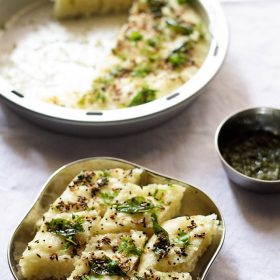
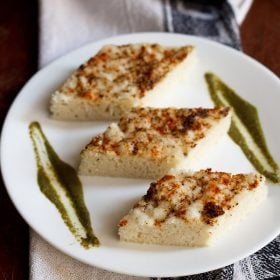
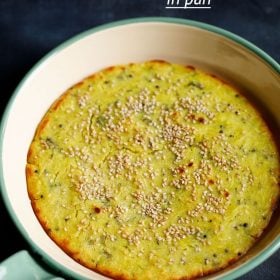
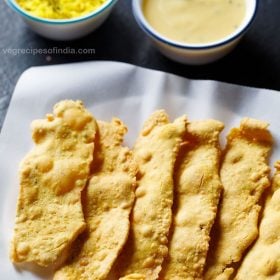
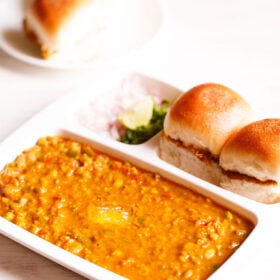
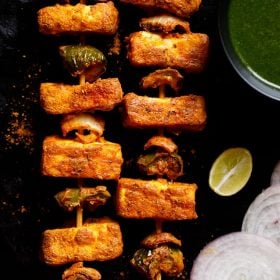
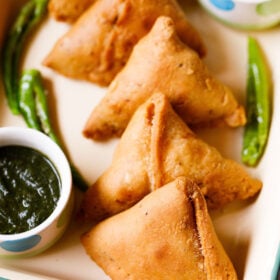
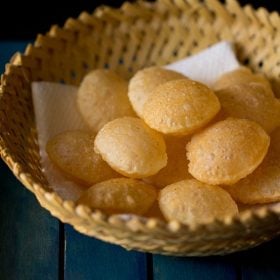








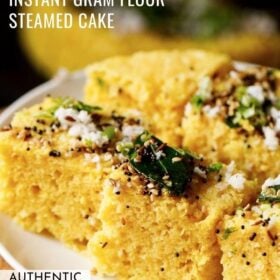
Thnks for ur delicious recipies .. Dhokla was very yummiee bt its lower part was bit hard.cn u suggest me the way to avoid dat issue?
simar, when you add the eno, you have to mix it really well. if not mixed very well, then some parts of the batter won’t be fluffy when cooked. also could be that the dhokla was steamed too much, hence the lower part became dense. next time, mix the eno very well with the batter. then after pouring the batter in a pan, gently shake the pan, so that the batter spreads and evens out in the pan. then steam the dhokla.
I really like your recipes and mostly d way u presented it..whenever i want to prepare any wish i definitely follow your way..
Thank u so much for such luvly guidance.
thank you much suman.
Thank you so much mam, with ur wonderful guidance I m nw able to prepare fine dhoklas,
glad to know this and thankyou maya also you are always welcome.
Hi can I skip sugar while tempering. Basically my husband doesn’t like sweetish tinge.thanks
yes you can skip sugar.
Dear madam
Thanks a lot for the recipe can I make the dhoklas in idle steamer
yes you can make. just steam dhokla, the way you steam idlis.
tried.. .its excellent!
second time I added a little (2 spns)of curd and a spn of veg oil.believe that gave a nice tangy taste and soft texture.do u think its fine?
another question ‘ should I keep the dhokla pan/mould uncovered while steamimg in the pressure cooker?
pl answer
thanks. its fine to add the extra teaspoons of curd and some oil. addition of oil gives a moistness to the dhokla. no need to keep the pan covered with anything while steaming in the cooker.
Hi dasana,
. can I use citric acid, instead of lemon juice?if yes in what proprtion..
Also I want to serve it in evening party , but make in morning, and I m confused as to how will it work, for tempering and also its softness
Thanks
Sonu
you can use citric acid. but i am not sure about the proportions. so can try with a small batch. make in the morning. then temper. before serving, just sprinkle some water and microwave for a few seconds. garnish with coconut and then serve. don’t add coconut after you temper. keep the dhokla covered in a bowl or container with a lid.
Ok… You mean not add water in temper, and garinish after with coconut??? Plz specify… Do I need to cut in pieces before tempering??
Sonu
yes do add water while tempering. then don’t garnish with coconut. you can though garnish with coriander leaves if you want. do keep the dhokla in a container. then before serving, just sprinkle a bit of water on them and microwave just to make them warm. then you garnish with coconut. yes you need to cut in pieces before tempering.
As usual another superlative experience from one of your recipe guides. My wife asked “how did you do this”. To my unbelievable credit I did not plagiarize. I said “it’s all on the Internet”. Dassana you are to be highly commended. Are you based in New Delhi? Send me your full postal details please. I do not believe in taking without giving. Best regards. Rohit.
thank you very much rohit for the kind words and for your thoughtful gesture. your gesture already has already made me feel good. so nothing more is required 🙂
fyi – i am not based in delhi. thanks once again.
Hi Dassana, its me again with a query….i made this dhokla again today… it did froth and also there were bubbles .. but while eating it felt very dry .. i followed exatly what you hv done… where am i going wrong .. did i put too much besan or less water while mixing or i dont know…. or i should steam it for a longer time .. pls help .. i dont want to fail the third time ….
thanks dassana for all your replies …
tk care and regards
marina
Okay. Dryness could be due to less water or too much steaming. So try adding a few tbsp more water or steam of lesd time. Welcome marina.
hi dassana, i had made this dhokala for the first time.. it did taste but it was not very soft … ofcourse it was not hard also … what could hv gone wrong.. i used eno lemon flavour.. when i added eno it did not froth and there were no bubbles .. u think that could be the reason or something else or at the end i used less water in the tadka ….
thanks for your reply in advance ..
rgds n tk care
marina
hi marina, the batter should froth and bubble as soon as you add eno. if it does not, then it means that the eno was not fresh, meaning it had expired and not active. this is also true for ingredients like baking soda and baking powder. so this could be the reason for the dhokla not being soft. for the tadka, its fine if you use less water. even if water is not added in the tadka, its fine.
I made dhokla today using microwave and it came out really well n tasted really gud. Except i felt the edge to b a bit hard , it ws nt dat mch noticable bt if eaten vry fast v cn feel it. Wat do you think can b d prob? Also my mum made dhokla wid curd. Wat if v substitute water wid curd? Thanx fr a great recipie …i always follow your recipes.
if the dhokla gets cooked too much in the microwave, it will harden. even if its cooked for some more seconds, it will get overcooked. with microwave, the food even gets cooked after its removed from the microwave oven. so while making any dish in the microwave, cook for some seconds or minutes check the doneness and if not cooked, then again place the pan in the microwave. you can add curd instead of water. but i would suggest adding both water and curd. skip lemon juice, if you add curd.
I like this website
Hey!
I tried your dhokla recipe today. And midway realised i had just a teaspoon of eno instead of the two as needed in the recipe. So, i substituted equalequal measures of baking siad and powder to make up the lacking teaspoon.
Well guess what, the dhokla was well shaped and risen. I’m so glad. It was my first try at dhokla making.
Other than the rising agent, i wholly followed your recipe.
Haven’t tasted it yet, as we all are fasting for ramadan. It seems it will be delicious!
thanks wardah and good to know that the dhokla came out well 🙂
hi what can i use instead of lime juice???
you can use curd/yogurt.
Ur recipes always do woonders in my life. I was most happy person to make a perfect dhokla for my family. Thanks a ton.
welcome barnali. glad to know this.